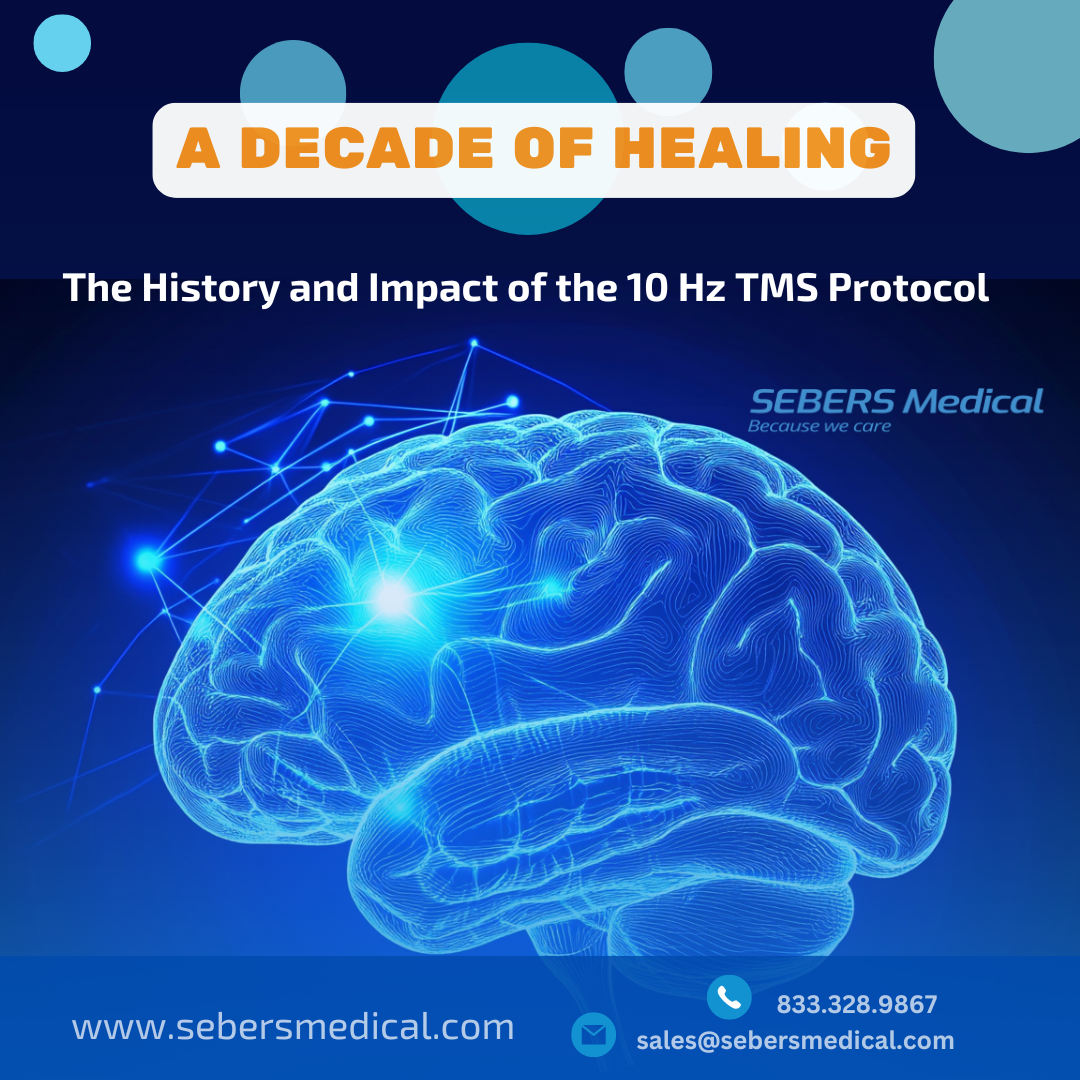Since the FDA approved the 10 Hz transcranial magnetic stimulation (TMS) protocol in 2008, this groundbreaking treatment has offered relief to tens of thousands of patients suffering from treatment-resistant depression worldwide. The 10 Hz protocol, targeting the left dorsolateral prefrontal cortex (DLPFC), has become a cornerstone of non-invasive brain stimulation therapies. Despite the advent of newer technologies like theta burst stimulation (iTBS), the 10 Hz protocol remains a highly effective and widely-used treatment in the field of psychiatry.
The Origins of the 10 Hz Protocol
The foundation for the 10 Hz TMS protocol was laid with several pioneering studies, but the gold standard study is the one conducted by O’Reardon et al. in 2007, which demonstrated that daily sessions of 10 Hz TMS were significantly more effective than sham treatments in reducing depression symptoms. This landmark study led directly to the FDA approval of TMS in 2008 as a treatment for major depressive disorder (MDD) in patients who had not responded to conventional treatments.
How the Protocol Works
The 10 Hz protocol involves delivering high-frequency pulses to the left DLPFC, an area of the brain associated with mood regulation. Each session traditionally lasted 37.5 minutes, delivering 3,000 pulses, but advancements in TMS technology have shortened session times to roughly 19 minutes over the years, improving patient comfort while maintaining the protocol’s efficacy.
Proven Efficacy Over the Years
The 10 Hz protocol’s ability to offer consistent and meaningful relief for individuals with depression has been proven in countless studies and patient experiences. Even after 16 years of clinical use, it continues to demonstrate high rates of remission and symptom reduction, helping patients who have not responded to antidepressants and psychotherapy. As noted in studies such as George et al. (2010), the protocol is especially beneficial for those with less treatment-resistant forms of depression, with remission rates significantly higher than sham treatments.
The Rise of New Technologies: Theta Burst and Beyond
In recent years, new neurostimulation technologies like intermittent theta burst stimulation (iTBS) have emerged, offering even shorter treatment times (as little as 3 minutes per session) without sacrificing efficacy. For example, the Blumberger et al. (2018) study highlighted the effectiveness of iTBS as a non-inferior alternative to 10 Hz, making it an attractive option for some clinics and patients(
Additionally, recent advancements, such as those discussed in this 2021 study, continue to explore different TMS approaches. Yet, despite these innovations, the 10 Hz protocol remains a trusted and reliable option for clinics around the world.
The Blossom TMS Device: Combining Tradition with Innovation
For clinics looking to incorporate TMS therapy efficiently, the Blossom TMS device is an ideal solution. With its advanced cooling technology, it prevents overheating during sessions, allowing for shorter treatment times without sacrificing performance. The Blossom TMS device is designed to make the 10 Hz protocol more accessible by reducing the logistical barriers clinics often face, such as long session times or machine downtime. For any clinic ready to get TMS up and running quickly, the Blossom TMS device offers the perfect combination of efficiency and proven effectiveness.
A Decade of Healing
Since its introduction, the 10 Hz protocol has been pivotal in helping tens of thousands of patients around the globe. While the field of brain stimulation continues to evolve, the 10 Hz protocol remains a gold standard. It has stood the test of time, offering patients a reliable and effective treatment for over a decade. Even with the rise of faster protocols like iTBS, the 10 Hz protocol’s consistent ability to alleviate the debilitating symptoms of depression has ensured its place in the arsenal of treatments for MDD.
As we look to the future, the 10 Hz protocol remains a symbol of hope and progress in the treatment of depression. It is a reminder that while new technologies will always emerge, sometimes the original solutions continue to provide the relief that patients need. The protocol’s success over the years speaks for itself, and it will undoubtedly continue to be a cornerstone of depression treatment worldwide.
- George, M. S., Lisanby, S. H., Avery, D., McDonald, W. M., Durkalski, V., Pavlicova, M., … & Sackeim, H. A. (2010). Daily left prefrontal transcranial magnetic stimulation therapy for major depressive disorder: a sham-controlled randomized trial. Archives of General Psychiatry, 67(5), 507–516. https://doi.org/10.1001/archgenpsychiatry.2010.46. Available at: PubMed.
- O’Reardon, J. P., Solvason, H. B., Janicak, P. G., Sampson, S., Isenberg, K. E., Nahas, Z., … & Sackeim, H. A. (2007). Efficacy and safety of transcranial magnetic stimulation in the acute treatment of major depression: a multisite randomized controlled trial. Biological Psychiatry, 62(11), 1208-1216. https://doi.org/10.1016/j.biopsych.2007.01.018. Available at: PubMed.
- Chung, S. W., Hoy, K. E., Fitzgerald, P. B. (2021). Theta-burst stimulation: A new form of TMS treatment for depression? Depression and Anxiety, 38(10), 994–1007. https://doi.org/10.1002/da.23147. Available at: PubMed.
